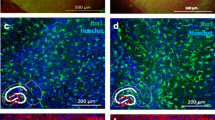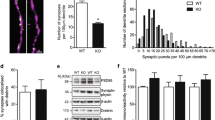Abstract
Advances in transgenic technology as well as in the genetics of Alzheimer disease (AD) have allowed the establishment of animal models that reproduce amyloid-beta plaques and neurofibrillary tangles, the main pathological hallmarks of AD. Among these models, 3xTg-AD mice harboring PS1 M146V, APP Swe and tau P301L human transgenes provided the model that most closely mimics human AD features. Although cortical cultures from 3xTg-AD mice have been shown to present disturbances in intracellular [Ca2+] homeostasis, the development of AD pathology in vitro has not been previously evaluated. In the current work, we determined the temporal profile for amyloid precursor protein, amyloid-β and tau expression in primary cortical cultures from 3xTg-AD mice. Immunocytochemistry and Western blot analysis showed an increased expression of these proteins as well as several phosphorylated tau isoforms with time in culture. Alterations in calcium homeostasis and cholinergic and glutamatergic responses were also observed early in vitro. Thus, 3x-TgAD cortical neurons in vitro provide an exceptional tool to investigate pharmacological approaches as well as the cellular basis for AD and related diseases.








Similar content being viewed by others
References
Billings LM, Oddo S, Green KN, McGaugh JL, LaFerla FM (2005) Intraneuronal Abeta causes the onset of early Alzheimer’s disease-related cognitive deficits in transgenic mice. Neuron 45:675–688
Caroni P (1997) Overexpression of growth-associated proteins in the neurons of adult transgenic mice. J Neurosci Methods 71:3–9
Dickey CA, Gordon MN, Mason JE, Wilson NJ, Diamond DM, Guzowski JF, Morgan D (2004) Amyloid suppresses induction of genes critical for memory consolidation in APP + PS1 transgenic mice. J Neurochem 88:434–442
Gandia L, Montiel C, Garcia AG, López MG (2008) Calcium channels for exocytosis: functional modulation with toxins. CRC Press, Boca Raton
Garcia DA, Bujons J, Vale C, Sunol C (2006) Allosteric positive interaction of thymol with the GABAA receptor in primary cultures of mouse cortical neurons. Neuropharmacology 50:25–35
Gimenez-Llort L, Blazquez G, Canete T, Johansson B, Oddo S, Tobena A, LaFerla FM, Fernandez-Teruel A (2007) Modeling behavioral and neuronal symptoms of Alzheimer’s disease in mice: a role for intraneuronal amyloid. Neurosci Biobehav Rev 31:125–147
Green KN, LaFerla FM (2008) Linking calcium to Abeta and Alzheimer’s disease. Neuron 59:190–194
Grynkiewicz G, Poenie M, Tsien RY (1985) A new generation of Ca2+ indicators with greatly improved fluorescence properties. J Biol Chem 260:3440–3450
Hung AY, Koo EH, Haass C, Selkoe DJ (1992) Increased expression of beta-amyloid precursor protein during neuronal differentiation is not accompanied by secretory cleavage. Proc Natl Acad Sci USA 89:9439–9443
Iqbal K, Grundke-Iqbal I (2006) Discoveries of tau, abnormally hyperphosphorylated tau and others of neurofibrillary degeneration: a personal historical perspective. J Alzheimers Dis 9:219–242
Köpke E, Tung YC, Shaikh S, Alonso AC, Iqbal K, Grundke-Iqbal I (1993) Microtubule-associated protein tau. Abnormal phosphorylation of a non-paired helical filament pool in Alzheimer disease. J Biol Chem 268:24374–24384
LaFerla FM, Oddo S (2005) Alzheimer’s disease: Abeta, tau and synaptic dysfunction. Trends Mol Med 11:170–176
Levin ED, Lee C, Rose JE, Reyes A, Ellison G, Jarvik M, Gritz E (1990) Chronic nicotine and withdrawal effects on radial-arm maze performance in rats. Behav Neural Biol 53:269–276
McLean CA, Cherny RA, Fraser FW, Fuller SJ, Smith MJ, Beyreuther K, Bush AI, Masters CL (1999) Soluble pool of Abeta amyloid as a determinant of severity of neurodegeneration in Alzheimer’s disease. Ann Neurol 46:860–866
Mercken M, Vandermeeren M, Lubke U, Six J, Boons J, Van de Voorde A, Martin JJ, Gheuens J (1992) Monoclonal antibodies with selective specificity for Alzheimer Tau are directed against phosphatase-sensitive epitopes. Acta Neuropathol 84:265–272
Morrissette DA, Parachikova A, Green KN, Laferla FM (2008) Relevance of transgenic mouse models to human Alzheimer disease. J Biol Chem 284(10):6033–6037
Oddo S, LaFerla FM (2006) The role of nicotinic acetylcholine receptors in Alzheimer’s disease. J Physiol Paris 99:172–179
Oddo S, Caccamo A, Kitazawa M, Tseng BP, LaFerla FM (2003a) Amyloid deposition precedes tangle formation in a triple transgenic model of Alzheimer’s disease. Neurobiol Aging 24:1063–1070
Oddo S, Caccamo A, Shepherd JD, Murphy MP, Golde TE, Kayed R, Metherate R, Mattson MP, Akbari Y, LaFerla FM (2003b) Triple-transgenic model of Alzheimer’s disease with plaques and tangles: intracellular Abeta and synaptic dysfunction. Neuron 39:409–421
Oddo S, Caccamo A, Green KN, Liang K, Tran L, Chen Y, Leslie FM, LaFerla FM (2005) Chronic nicotine administration exacerbates tau pathology in a transgenic model of Alzheimer’s disease. Proc Natl Acad Sci USA 102:3046–3051
Porzig R, Singer D, Hoffmann R (2007) Epitope mapping of mAbs AT8 and Tau5 directed against hyperphosphorylated regions of the human tau protein. Biochem Biophys Res Commun 358:644–649
Smith IF, Green KN, LaFerla FM (2005a) Calcium dysregulation in Alzheimer’s disease: recent advances gained from genetically modified animals. Cell Calcium 38:427–437
Smith IF, Hitt B, Green KN, Oddo S, LaFerla FM (2005b) Enhanced caffeine-induced Ca2+ release in the 3xTg-AD mouse model of Alzheimer’s disease. J Neurochem 94:1711–1718
Stutzmann GE, Caccamo A, LaFerla FM, Parker I (2004) Dysregulated IP3 signaling in cortical neurons of knock-in mice expressing an Alzheimer’s-linked mutation in presenilin1 results in exaggerated Ca2+ signals and altered membrane excitability. J Neurosci 24:508–513
Stutzmann GE, Smith I, Caccamo A, Oddo S, Parker I, Laferla F (2007) Enhanced ryanodine-mediated calcium release in mutant PS1-expressing Alzheimer’s mouse models. Ann NY Acad Sci 1097:265–277
Vale C, Damgaard I, Sunol C, Rodriguez-Farre E, Schousboe A (1998) Cytotoxic action of lindane in neocortical GABAergic neurons is primarily mediated by interaction with flunitrazepam-sensitive GABA(A) receptors. J Neurosci Res 52:276–285
Vale C, Vilaro MT, Rodriguez-Farre E, Sunol C (1999) Effects of the conformationally restricted GABA analogues, cis- and trans-4-aminocrotonic acid, on GABA neurotransmission in primary neuronal cultures. J Neurosci Res 57:95–105
Walton HS, Dodd PR (2007) Glutamate-glutamine cycling in Alzheimer’s disease. Neurochem Int 50:1052–1066
Zheng-Fischhofer Q, Biernat J, Mandelkow EM, Illenberger S, Godemann R, Mandelkow E (1998) Sequential phosphorylation of Tau by glycogen synthase kinase-3beta and protein kinase A at Thr212 and Ser214 generates the Alzheimer-specific epitope of antibody AT100 and requires a paired-helical-filament-like conformation. Eur J Biochem 252:542–552
Acknowledgments
This work was funded with grants from Ministerio de Ciencia y Tecnología, Spain: AGL2006-08439/ALI, AGL2007-60946/ALI, Ministerio Educación y Ciencia SAF2006-13642. From Xunta de Galicia, Spain: GRC 30/2006, PGIDIT 07MMA006261PR and PGIDT07CSA012261PR, PGDIT 07MMA006261PR, 2008/CP389 (EPITOX, Consellería de Innovación e Industria, programa IN.CI.TE.) and 2009/053 from Conselleria de Educación e Ordenación Universitaria. From EU VIth Frame Program: IP FOOD-CT-2004-06988 (BIOCOP), and CRP 030270-2 (SPIES-DETOX). From EU VIIth Frame Program: 211326-CP (CONffIDENCE); STC-CP2008-1-555612 (Atlantox). E. Alonso is recipient of a predoctoral fellowship from Ministerio de Sanidad y Consumo, Spain.
Author information
Authors and Affiliations
Corresponding author
Rights and permissions
About this article
Cite this article
Vale, C., Alonso, E., Rubiolo, J.A. et al. Profile for Amyloid-β and Tau Expression in Primary Cortical Cultures from 3xTg-AD Mice. Cell Mol Neurobiol 30, 577–590 (2010). https://doi.org/10.1007/s10571-009-9482-3
Received:
Accepted:
Published:
Issue Date:
DOI: https://doi.org/10.1007/s10571-009-9482-3




